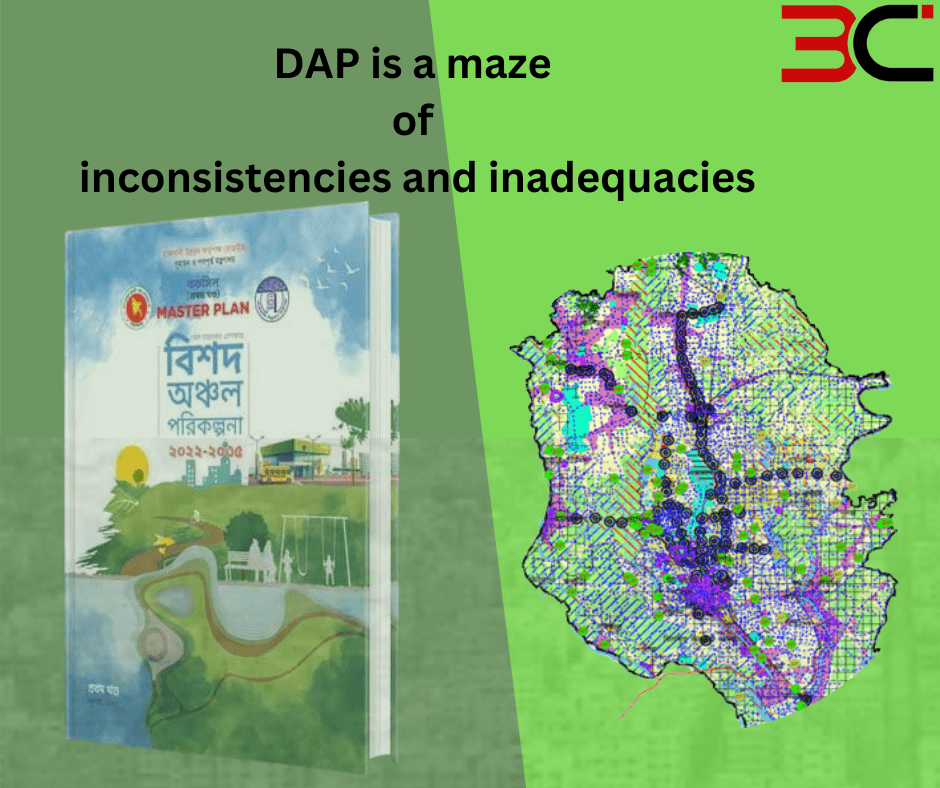Humans have struggled since prehistoric times to meet their basic survival needs. As civilization has progressed, our needs have changed and expanded but despite all this, the main objective is to fulfill the basic needs of people for survival. And for this purpose, people are migrating from country to country where they can get the assurance of meeting their needs. Dhaka, the capital of Bangladesh, is one such place. For more than 400 years, today’s Dhaka has taken a complete form by fulfilling the various needs of people. During this time, various people from the country and outside the country came to Dhaka and started living permanently, as a result of which the density of Dhaka started increasing. From the Town Improvement Act (TIA) of 1953 to the present Detailed Area Plan (DAP), various people have tried to plan Dhaka but none of the plans have seen much success because all the plans have failed to meet the basic needs of the common people. Today, in the first part of my series of discussions, I will talk about some of the inconsistencies and inadequacies of the newly gazetted DAP 2022-2035, due to which DAP is likely to become the most failed scheme in the history of Dhaka.
Planned Area – The new DAP states that the area was recorded as 1528 sq km in the old DAP 2010, but a review of the GIS database found 1432 sq km. Later, 96 sq km was added in DAP 2022-2035 the question is, what benefit is being gained by adding 96 square kilometers of land to the new DAP in Gazipur and Dhamsona? Rather, all the existing buildings and agricultural land, reservoirs, rivers, canals, and all the natural and unnatural resources of the area have come under the land use of DAP. Conditional development has been given in many open spaces, agricultural lands, etc. It is like dragging the village into the city, which is completely incompatible with the natural habitat of the people in the topography, economy, and society of the area and it will expose the extended city to various natural and unnatural disasters in the future.
Population – In neighboring countries India, the Census Commission defines a metropolitan city as a city with a population of 1 million or more and a megacity as a city with a population of 10 million or 1 crore or more. According to BBS 2011 estimates, Dhaka has a population of 15.51 million. The projected population in 2035 is 26.10 million as per the new DAP. By increasing the size of Dhaka by making the surrounding population residents of Dhaka, putting Dhaka in the definition of the metropolitan or mega-city, has Dhaka Town been made a metropolitan or mega-city to get funds from UNDP or ADB? The reasons for increasing the size of Dhaka repeatedly by RAJUK also need to be carefully examined in whose interest it has been done.
Principles of planning – It says universal freedom of investment, a better quality of life, sustainable cities, ecological conservation, etc. but these have no match with the inside. The floor area ratio makes the FAR a maze as the height of the building decreases. As a result, people’s desire to invest in Dhaka is decreasing day by day. People have to face financial losses in all fields related to the construction industry including cement, rods, tiles, lifts, bricks, sand, etc. The future is dark for those who are currently doing business with VAT, and taxes to the government. This DAP is an attempt to damage the business of ordinary traders by setting up shops on the footpaths. If we compare sustainable development with the principle of DAP, we will see that this DAP has been prepared completely ignoring industry and sustainable development, which none of us wanted.
Mauza Database of Rivers and Canals – DAP developers claim that they are the first in Bangladesh to introduce CS, RS, and MS and have prepared a digital database of identified rivers, canals, and ponds in Mauza in Dhaka city. Here they proposed a total of 13% land use zones in all planning areas and proposed mixed land use types. Where mixed use is claimed to mean controlled mixed use. Bangladesh is the motherland of rivers where the Himalayan ice melts every year due to geographical reasons, the waters of high places flow through Bangladesh and fall into the Bay of Bengal. Dhaka is a city surrounded by rivers nowhere else in the world. All the water-related utilities of the city go to the river through canals, which naturally flow into the sea. And here this DAP has allowed the mixed-use subject to conditions, which I think is an ill-conceived plan just like killing Dhaka by increasing the waterlogging of Dhaka city. My request is to remove all the proposals made on the rivers and canals and keep the rivers and canals functioning through re-management and make a plan to save Dhaka from flooding.
Overlay Zone – Here the DAP makers have identified the overlay zone as a special management zone rather than as a land use zone. Eg: flood flow area. This is because overlay zones can be variable and determined by other regulators outside of city planning, they said. A plan must be made keeping in mind the future where there should have been an account of how the overlay zone would change if it was changed and there should have been an idea of what effect the implementation of this plan would have on the overlay zone which is missing in this DAP. By no means is a detailed plan if the maker lacks knowledge and experience.
Floodplains – Floodplains have been identified in the entire Rajuk area by developing a two-dimensional mathematical model of riverine flooding in the urban planning report. DAP’s floodplains are divided into three categories: general floodplain area, general watershed area, and main watershed area. Problem is, that areas are not proposed as land use zones but inserted as overlay zones. In the overlay zone, they have already said a change can be made by different controllers. Then the floodplain is also becoming a special management zone. Again they say that the land use of the flood-flow areas is not flood-flow areas the land use of these areas is historically agricultural. What does that mean? DAP for 2022-2035 has included flood lands as overlay zone and called overlay zone as variables so these agricultural lands are planned to be changed to any other zone in the future. What kind of plan could there be?
The makers of DAP said that not considering the floodplain area as a separate property but rather taking into consideration the contemporary concept of living with water, it has been recommended to allow construction only in areas of general public flow subject to special conditions. It is as if instead of removing waterlogging, the water itself was removed and housing was arranged. In these places, the local people did not alter the flood plains to save them from flooding for so many years and when the rainy season went away and the water receded, the lands were cultivated in various ways for ages. By offering housing that ignores water flows and seasonal agriculture from those places, the DAP is not only an expression of high commercial spirit but also evidence of the environment, nature, neighborhood, and disaster planning. There is no alternative to immediately withdrawing all these ill-conceived schemes from DAP and making it more people-friendly and in balance with nature.
Nagar Jivan Rekho in DAP 2022-2035 – Since the matter of roads is mentioned, it would be better to say a little more than DAP has said that in the case of block development in 2022-2035, the FAR value is less than 1.5 and the amount of space is from 10 Katha to 20 Katha, 25 feet in the planned area and 20 feet road is acceptable in the unplanned area. Landlords or owners can construct their buildings as per MGC and setback building norms by leaving 30% park or playground area along the 25 or 20 feet road. However, according to the 2008 rules, we found that there should be a minimum of 30 feet of road in 10 to 12 Katha areas. The more developed areas of the world we observe, the more advanced civilizations we will find along the wide roads. However, after having such a good proposal in 2008, the proposal to construct buildings next to 20 feet or 25 feet roads in 2022-2035 seems to be pulling us further back. DAP also said that 1 lakh fruit trees, 50 thousand wood trees, and an equal number of medicinal plants will be planted on this road. And about seventy-two thousand fruit trees, 36 thousand wood trees, and an equal number of medicinal plants have been planned to be planted in the waterway. How does DAP propose this when the Strategic Transport Plan is being revised? By proposing eco-parks in forests, and constructing conditional buildings in flood-flow areas, where roads and waterways are supposed to be improved, we have gone further back with these unrealistic proposals.
Population Zoning Plan – DAP 2022-2035 has prepared area-wise population density zoning based on the existing carrying capacity of the area, carrying capacity of road infrastructure, existing civic amenities, level or type of existing development, and other parameters. Here determined the maximum allowable population density and building distance of the specific area concerning the Khana-Income-Expenditure calculation and the acceptable maximum limit of the city’s population density and the carrying capacity of the area. It is good to say that in most areas the permissible population density is 200 per acre and in many places it is 150 and 180 which is just a dream and in very few areas and specially developed areas it is 250. If we look at other countries we find the density is 250 to 350 or even more per acre but their cities are very organized and people-friendly. With this DAP imposition of ours, the unit of the people has also been determined, giving the people a new taste of control in an independent country for the development of their resources. But the flood lands, agricultural lands, etc. have corrupted every letter of the Detailed Area Plan (DAP 2022-2035) prepared in the mother tongue by leaving some development opportunities for the beneficiaries.
Will continue ……
Reference:
- DAP 2022-2035, Volume 1, Annex. 3.3, Page: 456-459.
Author Details
Md. Mahamudur Rahman, (Architect, Environmentalist, and Disaster Management Expert)
Member, Environment & Urbanization Committee, 24th EC, IAB
“Establishment of Building Energy Efficiency & Environmental Rating (BEEER) system for SREDA“– on behalf of consultants.
Chief Architect/ Proprietor, Eco Design Consultants Bangladesh (EDCBD)
Former Architect/ Project Coordinator, Parikalpak Consultants Ltd.
Former Project Architect, Department of Architect, PWD.

